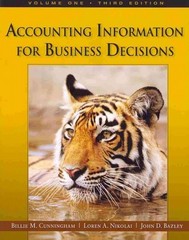Question
Some restaurants use customer checks with pre-numbered sequence codes. Each food server uses these checks to write up customer orders. Food servers are told not
Some restaurants use customer checks with pre-numbered sequence codes. Each food server uses these checks to write up customer orders. Food servers are told not to destroy any customer checks; if a mistake is made, they are to void that check and write a new one. All voided checks are to be turned in to the manager daily. How does this policy help the restaurant control cash receipts? Do you think there is a more efficient way to control cash receipts? Explain.
Post
It would be reasonable to assume the large businesses with thousands of employees would be at the greatest risk of fraud due to the fact that there are just too many people to adequately monitor, but this assumption would be incorrect. According to the 2018 report filed by the Association of Certified Fraud Examiners (ACFE), businesses with fewer than 100 employees reported 28% of reported instances of fraud, the highest percentage of any class. Although larger companies have more to monitor, they also have access to CPA firms and other experts who can help prevent fraud by reviewing and establishing superior internal controls, training employees and management on anti-theft techniques, and monitoring and reconciling accounts to ensure accurate reporting. Small businesses without these capabilities are often lacking in their internal controls, making them vulnerable to fraudulent acts.
Restaurants that utilize customer checks with pre-numbered sequence codes are attempting to mitigate those threats, By instructing the servers to never destroy any customer check, but rather void the check and create a new one in light of an error, the restaurant owner can match the days' receipts with the submitted checks. By using sequenced codes and numbers, the manager will be able to more easily detect any errors or omissions, and be able to determine the server who is associated with the check. It would be very difficult for the owner to physically observe every order, so this system helps prevent and deter against fraud. The owner needs to be wary of unintentional errors, as well as those that may be intentional, such as a server pocketing a payment or not charging their friends for a meal.
While a lot of smaller restaurants still utilize a check system, technological advances offer a more efficient way to control these transactions. Now, servers can enter and order into a computer system, which will prompt the cooks to prepare the meals. After the meals are prepared and served, payments can be entered into the same system, matching the food that was prepared with the payments received. This system would make it much harder for a server to perform many of the acts that could severely hurt small businesses. As technology advances and becomes more affordable, small businesses would be well-advised to upgrade their systems and their internal control procedures to cut down on the ongoing threats they face.
Required
Agree with the above by building upon their ideas or challenge their ideas and provide reasoning for the disagreement.
Step by Step Solution
There are 3 Steps involved in it
Step: 1

Get Instant Access to Expert-Tailored Solutions
See step-by-step solutions with expert insights and AI powered tools for academic success
Step: 2

Step: 3

Ace Your Homework with AI
Get the answers you need in no time with our AI-driven, step-by-step assistance
Get Started


